I never really thought about it. I always put my desk in front of the window to have enough light and a nice view. Turns out that was actually hurting my productivity.
So where is the best place to put a desk while studying? The following rules determine the best position for your study desk:
- Do not sit with your back to the door
- Your desk should not be placed in front of a wall
- Do not sit in front of a window
These 3 rules are the common ground of all the different approaches I found. But Feng Shui adds some more things to consider.
The 3 rules of study desk placement
- The first one is quite obvious if you ever had your back facing to the door. If you are fully focused and immersed in your study and suddenly someone sneaks up on you (on purpose or not) and touches your shoulder that is pretty scary. You will be pulled out of your study “flow” and getting back often takes a while.
- Facing a wall (Especially an empty white one) feels very depressing. Loosing your good mood and enthusiasm to study is impairing your concentration, focus and studies show also your level of recalling the information you are trying to remember.
- Sitting in front of a window seems to be the evident choice when choosing a place to set up your desk. That this is something to avoid came quite as a surprise to me but now after my research, it makes sense. Looking out of the window especially into a beautiful environment like a garden distracts from the task at hand. Your mind starts to wander and you keep losing focus.
Enforce the 3 rules with Feng Shui
Facing away from the door is also one of the major concerns of Feng Shui. The reason is not being afraid that something scary is coming through the door. Feng Shui states that not being able to see the entrance can lead to missing a business opportunity that might walk by.
Facing the window in the eyes of Feng Shui is not all about the distractions that happen outside but rather the opening that allows your personal Qi to escape. During my time in China, I realized how embedded the importance of Qi is in daily life. Qi (which literally means air) could best be described as the personal energy flow embedded into everyone. Qi also plays a central role in traditional Chinese medicine and martial arts. I include the Chinese Character here to share the beauty of it.
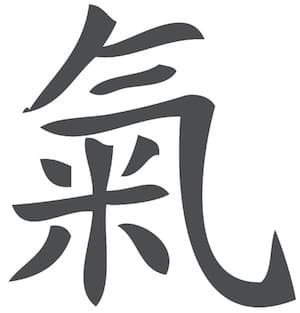
Probably a bit of topic but I really got hooked on the Chinese language. If you like to take a look at how these characters and the language work – I wrote a book about it (link is here on my resource page). It is easier than you think.
Feng Shui is not directly saying the desk should not be placed in front of a wall but indirectly supporting this rule with what it calls the command position. In essence, this is to place the mean furniture of the room so that you can deal with whatever enters your life. This place in the room should follow these simple rules:
- Have the door in sight
- Don’t be in one line with the door
- Have a good backing behind you (like a wall)
- Be as far away from the door as possible
This of course implies that the desk is not in front of a wall (except the room is
Applying the rules – the transformation
So, after discovering so many things that can go wrong when designing your study room I analyzed my layout to check what mistakes block my productivity. This is how my study room looked like before:
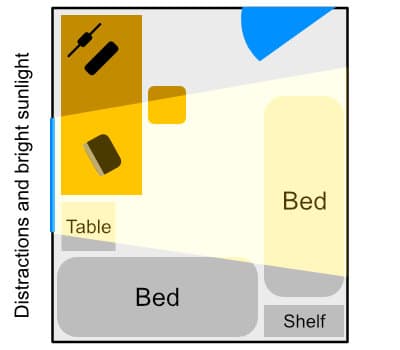
So many errors! Let’s take a look
- The chair faces with the back to the door
- The desk is half against a wall, half in front of a window
- The light splits in the middle of the desk creating a high contrast between the notebook in the light and my desktop/note taking area in the shadow
- The windows view always lets my mind wander
- The room is clearly too cluttered
After I applied all the things I have learned during my research the layout of my room changed to this:
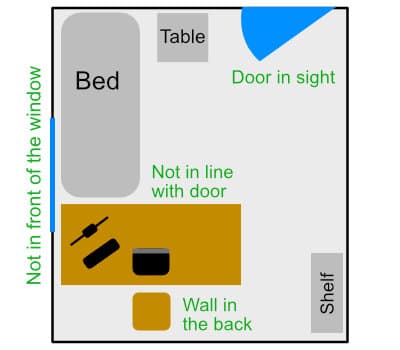
Believe it or not, I command the room now. The difference and the feeling of sitting behind my desk is such a huge difference. Study and work feel so much more relaxed and with the light coming from the side the desk is equally lit and shadows are minimized.
Doublecheck my desk placement with the Bagua map
I found my wife during the 8 years I lived in Shanghai. She is a native Chinese so I asked her for her opinion when I was reorganizing my study room. She suggested I also take the Bagua map into consideration. What is that?
This was not supposed to be an article about Feng Shui but now that I was hooked I tried to complete my study room analysis and make it perfect. Bagua (the 8 trigrams) is one of the main tools of Feng Shui best described as the energy map. It basically divides a space into 9 areas each with a different energy focus and can not only be applied to rooms but also the entire house or the desk itself. Let’s take a quick look at the 9 areas:
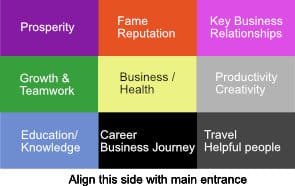
So if I lay the
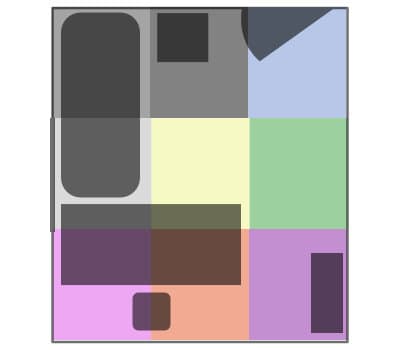
So here is what I did to apply my findings to my new room:
Blue -> Education & Knowledge: I could not really do something here because the whole sector needs to be empty for the door.
Green-> Growth & Teamwork: I got a huge whiteboard and attached it to the wall where I write down ideas, visions and study progress.
Violett -> Prosperity: I have a shelf in that corner and put among other things the lucky golden winking cat on it (also known as Maneki-Neko) which is originally a Japanese luck bringing figurine. But also in
Red -> Fame, Reputation: The wall behind my chair, I put up my frames certificates and successes. Feels good to have them in your back.
Pink -> Key business relationships: I have a tiny table with a coffee machine here. Not sure how I can relate that to business relationships. I just like coffee.
Light gray-> Productivity/Creativity: This is the area in front of the window with a bed/sofa, looking outside and letting my mind wander helps my creativity.
Dark grey -> Travel/Helpful people: I put a collage on the wall with snapshots from my travels.
Black -> Career/Business Journey: A small table here where I have a recharger for my devices. Basically my communication area.
Yellow-> Health: The center area is recommended to be empty. So all the business can just come my way.
Optimizing my desk with the same strategy
As I mentioned the Bagua Map can be applied to any space so I also optimized my desk with the same strategy. Let’s take a look at what I placed in the different areas:

Blue -> Education & Knowledge: Most of the knowledge nowadays comes from the computer. I didn’t really want to put some books here because that was rather disturbing. I decided to place my daily ToDo/ToStudy list (Usually using the Pomodoro method, you can read about it in my article about how to take effective study notes).
Green-> Growth, Core Health, Family: The areas of the Bagua map have multiple meanings. Here I chose the core health characteristic and put a small bowl of fruits there. Since family is also an option a picture of your loved ones might be suitable as well.
Violett -> Prosperity, Wealth, Abundance: Same here, I didn’t want to put up another winking cat but Feng Shui articles also assigned the meaning of Abundance to this part so I went with the recommendation to place a small plant in this corner
Red -> Fame, Reputation: I really did not want to look at some certificates or other self-endorsing items so I went with the expert’s recommendation here as well and simply put my desk lamp here. (You can learn more about lightning and study room color from this article).
Pink -> Key business relationships, Love, Marriage: Here I did not really have much of a choice. I always use a second monitor because it is so much more efficient when researching or reading something. I attached a small image of my wife below so I could honor the love and marriage aspect of this corner.
Light gray-> Productivity/Creativity: Though I do most of my planning and idea collection with Trello, I put a notepad and pen there to quickly jot down an idea or taking my study notes.
Dark grey -> Travel/Helpful people: Helpful people are usually saved in your phones contact list so it made sense to put my phone and pad here including charging station.
Black -> Career/Business Journey: Here I simply placed my MacBook.
Yellow-> Health: Like in the room setup I left this area empty as well.
Checking my study room against Vastu Shastra rules
During my research, I found that many people apply the rules of Vastu Shastra to their living environment. So I wanted to see if my newly designed study and office room had some more things I needed to change.
Vastu Shastra which translates to “Science of architecture” is a traditional Hindu System of architecture. The goal of Vastu is to eliminate negative and improve positive energy present at a location or place. Vastu is a huge topic like Feng Shui and I can only scratch the surface here. So I evaluated my new room according to a short Vastu checklist to further optimize my study area:
- The desk is facing to the east
- The study room is for study only
- Never study at the dining table
- Do not have your back or face to a toilet
- Avoid a blank or empty wall in front of you
- Don’t sit with your back towards the door
- Place your Computer on the right side of your desk, south-east
- Don’t use a desk/table made from iron with a glass top
- No mirrors or make-up items on the desk or in the drawer
- Don’t sit below a beam or slab
So far so good, but I also found a couple of things that needed improvement:
- Close open holes in the wall
- Remove unused nails
- Clean the desk every time before your study
- Remove pictures/figurines that represent pain (Heros, Players etc.)
- Close bookshelves, cupboards etc.
- Remove broken items like stationery and old books
- Cover the computer screen with a white cloth when not in use
So I got right on it, threw out all the old and broken things I kept, did a thorough cleaning and got some one-way cleaning towels to quickly wipe my desk before studying. Then I removed unused nails and filled the holes with some putty. I had a little fighter figurine on my shelf which I put into a box. Since the shelf could not really be closed I got some light colored boxes and put all the loose stuff inside so everything looks neat and tidy now. I don’t have a cover for my computer and/or monitor yet and I am not sure I am going to get one (The reason to cover it was to shield from electromagnetic radiation but I am not convinced that a cover is really protecting me nor that
That was quite a transformation. I am really happy with the result. Whether feng shui and Vastu Shastra really makes a difference or not was really not that important. Organizing and decluttering the study room and desk is already a huge win and the new desk placement even following the 3 basic rules was a major improvement. Before I was mostly sitting on the bed/sofa with my notebook on my knees because I did not really like sitting at my desk. That changed, I really enjoy my new command position and sitting in at my optimized study desk will not only improve my productivity I am sure but also lower the back pain I had from always sitting on the sofa.
Related questions
What is the best office/study desk direction per Vastru? Facing East is the best direction for your desk.
What is the ideal position of a computer screen? A lot of study and research time is spent in front of a computer. The perfect screen height for your monitor is when your eyes are at the same level as the top of the screen (or a little bit above).
What is the ideal standard desk height? Desk height is something individual therefore there is no one-size-fits-all desk height. The following table shows the correct seat height, chair, and desk height when sitting upright and having the elbows in a 90-degree angle on the desk.
| Height | Chair | Desk |
| 152 cm / 5’0″ | 36 cm / 14’0″ | 57 cm / 22’5″ |
| 155 cm / 5’1″ | 37 cm / 14’5″ | 58 cm / 23’0″ |
| 157 cm / 5’2″ | 38 cm / 15’0″ | 59 cm / 23’0″ |
| 160 cm / 5’3″ | 38 cm / 15’0″ | 60 cm / 23’5″ |
| 163 cm / 5’4″ | 39 cm / 15’5″ | 61 cm / 24’0″ |
| 165 cm / 5’5″ | 40 cm / 15’5″ | 62 cm / 24’5″ |
| 168 cm / 5’6″ | 41 cm / 16’0″ | 63 cm / 25’0″ |
| 170 cm / 5’7″ | 41 cm / 16’5″ | 64 cm / 25’0″ |
| 173 cm / 5’8″ | 42 cm / 16’5″ | 65 cm / 25’5″ |
| 175 cm / 5’9″ | 43 cm / 17’0″ | 66 cm / 26’0″ |
| 178 cm / 5’10” | 44 cm / 17’0″ | 67 cm / 26’5″ |
| 180 cm / 5’11” | 44 cm / 17’5″ | 68 cm / 27’0″ |
| 183 cm / 6’0″ | 46 cm / 18’0″ | 68 cm / 27’0″ |
| 185 cm / 6’1″ | 46 cm / 18’0″ | 69 cm / 27’5″ |
| 188 cm / 6’2″ | 48 cm / 19’0″ | 71 cm / 28’0″ |
| 191 cm / 6’3″ | 48 cm / 19’0″ | 72 cm / 28’5″ |
| 193 cm / 6’4″ | 49 cm / 19’5″ | 72 cm / 28’5″ |

6 thoughts on “Improve Your Study Room with Logic, Feng Shui and Vastu”